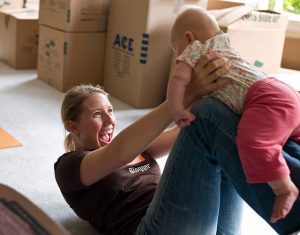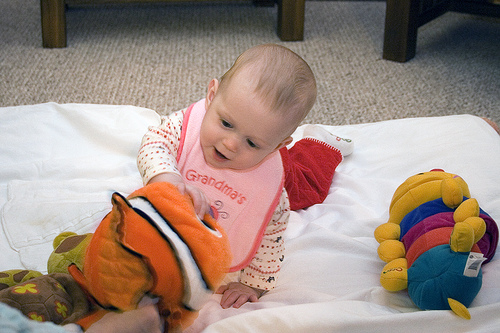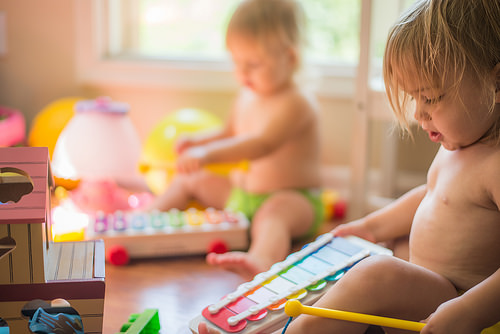Play With Your Baby To Provide Stimulation

We all learn by playing. In fact, games are the best way to acquire knowledge and develop skills in different areas. Play with your baby! Stimulate them!
In this article we will share with you some tips on the best ways to play with your baby according to their age.
Many people find it incredible that children can learn and develop so much while playing. Children learn and develop through games in the same way they can learn new languages through songs.
Through playful activities, children can learn how to communicate with those around them. Playing with your child is as important as talking to them or taking care of their health and nutrition.
According to The Parent’s Guide, published by the Spanish Association of Pediatrics, in a child’s early years there are certain actions and games that can promote their learning.
These activities stimulate their curiosity and develop their psychomotor skills.
Pediatricians stress the physical, intellectual, social and emotional benefits of adequate and precise stimulation. All of these activities should be carried out as though they were games and the child should never be forced to play.
Don’t overdo it. A few minutes a day are enough to practice most of the games and activities that we will share with you below.

Games according to age
The Parent’s Guide divides the games and ways to stimulate your baby according to their age. For example, during the first three months you can place the baby on its back and show them brightly colored toys and move it from one side to another.
You can also talk, smile, sing to them and make all sort of sounds while looking directly at their faces.
Don’t be afraid to put your finger in the palm of their hand and move their arms and body from one side to the other. You can also stretch their legs by slightly pulling their ankles.
When they are lying on their stomachs you can also show them objects in front of their faces. Raise the object when you get their attention.
Playing is an essential activity for the development and education of a child. (…) The quality and quantity of a child’s playing hours will undoubtedly help provide knowledge, psychomotor skills and social skills necessary for adult life.
-Rosa Jove, psychologist–
Movement and color
Between the age of three to six months we can repeat the games we carried out in the previous stage. In addition, you can blow kisses to them, stick out your tongue and make sounds that get their attention.
They can also be stimulated when you hold their hands together, making them touch one and other. Another stimulation method is to gently pull them by their forearms in order to make them assume a sitting position.
Beneficial results can also be seen by applying a little bit of pressure on the soles of their feet in order to get them to extend their legs. Try to put an object in their hands and when they are able to hold on to it you can take it out and repeat the process.
Between six and nine months we can show them objects with bright colors that make sounds. This will make them follow the object with their view. You can move the object closer to them and then take away the object. This process should also be repeated.
Show them a mirror so they can look at themselves while you repeat their name. You can also cover their face with a little handkerchief and wait for them to remove it and when they do, you can call them by their name.
Speaking with gestures and repeating syllables is also a good way to stimulate your child during this stage.
It doesn’t have to be an elaborate game, you can simply explain to them in very simple terms what you are doing when you spend time with them. Give them objects in both hands and encourage them to bring the objects together.
You can also make them aware of their feet by donning them with flashy socks. Stimulate body movement (turning around) by lying next to them and call them by their name.

Play and recognize
According to psychologist Rosa Jove, spontaneous and creative playing is much more effective if it is done with everyday objects. This causes the child to build elements with their imagination.
This will help them explore and discover greater possibilities. They will learn the uses and dimensions of objects. Keep in mind that between nine and twelve months you can already start to show them children books with animals while imitating their sounds.
Another simple game is to encourage them to touch different textures. You can also stimulate them by changing your facial expressions, making noises with your lips, giving kisses, wrapping toys in paper and waiting for them to unwrap them, etc.
It is also very useful to offer them cubes of different sizes for them to play with. Help them to stand or walk by holding onto them by their armpits or hands. This will help them to develop their motor skills.
Between 12 and 15 months we should help them walk and climb stairs by holding their hands. Teach them to put objects in containers, make towers with cubes, turn pages, hold spoons, drink from a cup and open and close containers.
We can also teach them about their body parts. By showing them a picture of themselves or a mirror we can help stimulate memory and other cognitive processes.
During this stage we should ask them to help when taking of their clothes. We can also let them eat on their own and ask them to do little tasks such as taking on bringing things.
After 18 months helping them go up and down stairs can be very beneficial. You can also give them a ball to kick around. Showing them images in books is very important for the development of language.
You should also start to speak to them using simple phrases. Hide toys around the house that they can find later.
We all learn by playing. In fact, games are the best way to acquire knowledge and develop skills in different areas. Play with your baby! Stimulate them!
In this article we will share with you some tips on the best ways to play with your baby according to their age.
Many people find it incredible that children can learn and develop so much while playing. Children learn and develop through games in the same way they can learn new languages through songs.
Through playful activities, children can learn how to communicate with those around them. Playing with your child is as important as talking to them or taking care of their health and nutrition.
According to The Parent’s Guide, published by the Spanish Association of Pediatrics, in a child’s early years there are certain actions and games that can promote their learning.
These activities stimulate their curiosity and develop their psychomotor skills.
Pediatricians stress the physical, intellectual, social and emotional benefits of adequate and precise stimulation. All of these activities should be carried out as though they were games and the child should never be forced to play.
Don’t overdo it. A few minutes a day are enough to practice most of the games and activities that we will share with you below.

Games according to age
The Parent’s Guide divides the games and ways to stimulate your baby according to their age. For example, during the first three months you can place the baby on its back and show them brightly colored toys and move it from one side to another.
You can also talk, smile, sing to them and make all sort of sounds while looking directly at their faces.
Don’t be afraid to put your finger in the palm of their hand and move their arms and body from one side to the other. You can also stretch their legs by slightly pulling their ankles.
When they are lying on their stomachs you can also show them objects in front of their faces. Raise the object when you get their attention.
Playing is an essential activity for the development and education of a child. (…) The quality and quantity of a child’s playing hours will undoubtedly help provide knowledge, psychomotor skills and social skills necessary for adult life.
-Rosa Jove, psychologist–
Movement and color
Between the age of three to six months we can repeat the games we carried out in the previous stage. In addition, you can blow kisses to them, stick out your tongue and make sounds that get their attention.
They can also be stimulated when you hold their hands together, making them touch one and other. Another stimulation method is to gently pull them by their forearms in order to make them assume a sitting position.
Beneficial results can also be seen by applying a little bit of pressure on the soles of their feet in order to get them to extend their legs. Try to put an object in their hands and when they are able to hold on to it you can take it out and repeat the process.
Between six and nine months we can show them objects with bright colors that make sounds. This will make them follow the object with their view. You can move the object closer to them and then take away the object. This process should also be repeated.
Show them a mirror so they can look at themselves while you repeat their name. You can also cover their face with a little handkerchief and wait for them to remove it and when they do, you can call them by their name.
Speaking with gestures and repeating syllables is also a good way to stimulate your child during this stage.
It doesn’t have to be an elaborate game, you can simply explain to them in very simple terms what you are doing when you spend time with them. Give them objects in both hands and encourage them to bring the objects together.
You can also make them aware of their feet by donning them with flashy socks. Stimulate body movement (turning around) by lying next to them and call them by their name.

Play and recognize
According to psychologist Rosa Jove, spontaneous and creative playing is much more effective if it is done with everyday objects. This causes the child to build elements with their imagination.
This will help them explore and discover greater possibilities. They will learn the uses and dimensions of objects. Keep in mind that between nine and twelve months you can already start to show them children books with animals while imitating their sounds.
Another simple game is to encourage them to touch different textures. You can also stimulate them by changing your facial expressions, making noises with your lips, giving kisses, wrapping toys in paper and waiting for them to unwrap them, etc.
It is also very useful to offer them cubes of different sizes for them to play with. Help them to stand or walk by holding onto them by their armpits or hands. This will help them to develop their motor skills.
Between 12 and 15 months we should help them walk and climb stairs by holding their hands. Teach them to put objects in containers, make towers with cubes, turn pages, hold spoons, drink from a cup and open and close containers.
We can also teach them about their body parts. By showing them a picture of themselves or a mirror we can help stimulate memory and other cognitive processes.
During this stage we should ask them to help when taking of their clothes. We can also let them eat on their own and ask them to do little tasks such as taking on bringing things.
After 18 months helping them go up and down stairs can be very beneficial. You can also give them a ball to kick around. Showing them images in books is very important for the development of language.
You should also start to speak to them using simple phrases. Hide toys around the house that they can find later.
All cited sources were thoroughly reviewed by our team to ensure their quality, reliability, currency, and validity. The bibliography of this article was considered reliable and of academic or scientific accuracy.
- Fajardo, Z. I. E., Pazmiño, M. I. A., & Dávalos, Á. A. M. (2018). La estimulación temprana como factor fundamental en el desarrollo infantil. Espirales Revista Multidisciplinaria de investigación, 2(14). http://revistaespirales.com/index.php/es/article/view/229
- Liliana, S. (2010). Estimulación temprana. Guía de actividades para niños de hasta 2 años. Ediciones LEA.
- Salinas, Z. B., & Alvarado, J. M. (2015). Estimulación temprana para potenciar la inteligencia psicomotriz: importancia y relación/Importance and relationship in early stimulation to enhance psychomotor intelligence in infants. Ciencia Unemi, 8(15), 110-118. http://181.188.214.100/ojs/index.php/cienciaunemi/article/view/205
This text is provided for informational purposes only and does not replace consultation with a professional. If in doubt, consult your specialist.








